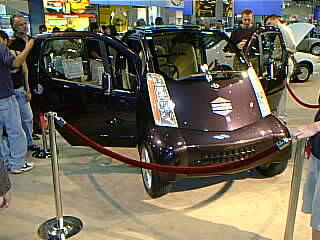
Home - AFV Events - Auto Shows - 1999 L.A. Auto Show
The 1999 Greater Los Angeles Auto Show was held 2-10 January 1999 at the L.A. Convention Center; I visited it on 3 January 1999, and saw more alternative-fuel vehicles there than I have at any previous auto show! There were a couple of disappointments, things I had heard of and hoped to see that weren't there, but on the whole the picture is of increasing interest on the part of every major automaker.
Where to start? Well, if you were at the Alameda EV Expo last October, you would have seen a lot of small two-seater electric vehicles (EVs), suitable for city commutes and light errand-running. In this class, Nissan brought their new Hypermini concept car to Los Angeles:

The Nissan folks there told me that they may offer this for sale in the United States for the 2001 model year, which is also when they may start actually selling their Altra full-size EV, which is currently only available for lease to fleets:
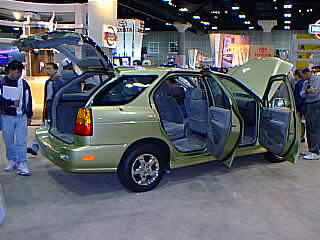
This is the first time I'd seen the Altra at a mainstream auto show unlocked so people could get behind the wheel, pop the hood, and the like; there was one all buttoned up at last year's L.A. Auto Show (and one was available for test-drives at the Alameda EV Expo!). Above I called the Altra a "full-size" EV; it's actually more like king-size, second among passenger EVs only to the Dodge EPIC minivan, which was also here and unlocked for the first time I've seen at an auto show (though again you could have test-driven one at Alameda).
Dodge also brought their Intrepid ESX2 concept car, a diesel-electric hybrid that I saw at the Anaheim Auto Show last October. I read that Dodge's parent company, DaimlerChrysler, had previewed an electric Jeep Commander to the press before the show, but it wasn't on display; this will be converted to a fuel-cell electric vehicle later this year. For a couple of years Chrysler has been working on a system to extract hydrogen for the fuel cell from gasoline, a process called "reforming": this lets the hydrogen be stored aboard the vehicle in compact tanks as part of a liquid fuel instead of in bulky pressure vessels as a pure gas. Daimler-Benz, however, which just merged with Chrysler, has been working for a long time with Ballard and others on fuel-cell drivetrains that obtain hydrogen by reforming methanol, and this technology is taking the lead in the combined company's efforts.
Toyota brought their Prius hybrid (still buttoned up) and RAV4 EV, which I saw in Alameda and Anaheim, and their e-com commuter minicar, which I saw in Alameda; they also had something new, a 1999 Camry powered by compressed natural gas (CNG). While I was on the road in my CNG van, driving Clean Across America And Back last August, I corresponded with Brent Crary of the Toyota Technical Center USA in Ann Arbor, Michigan about the details of refueling such a vehicle, and I am very glad to see the car ready for leasing to fleets! The Camry looks like a particularly good choice for a CNG passenger car; commonly an automaker (or a conversion company) will put the large, typically multiple fuel tanks in the trunk, which can cut into available cargo space pretty badly, but the Camry's trunk is so deep in stock form that you still have plenty of cargo volume even when half of it is filled up by the tanks:
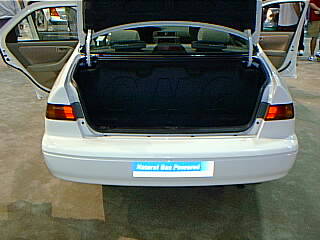
This is one reason that most CNG vehicles made today are vans or trucks: they have more space to put tanks and still have large amounts of cargo volume available. You can put all the tanks under the body as on my van or you can put some in a pickup bed, as on this Ford F250:
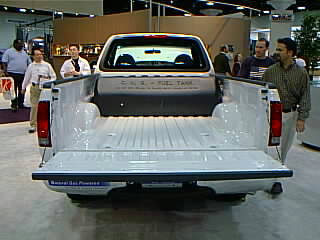
I've seen toolboxes use up more space than this! This is the first CNG Ford truck I can remember seeing at an auto show; they also brought the 1999 Ranger compact pickup EV with nickel metal hydride (NiMH) advanced batteries, and as I noted in my report on the Anaheim Auto Show, all 1999 Rangers with 3.0 liter V6 engines are capable of burning up to 85% ethanol (E85).
The GM EV1 was, of course, on display in the Saturn area; the model there was the new 1999 with optional NiMH batteries, which I had a chance to drive at the 1999 EV1 Rollout last month. They also had a "wireframe" full-scale model showing the batteries and powertrain of this car:
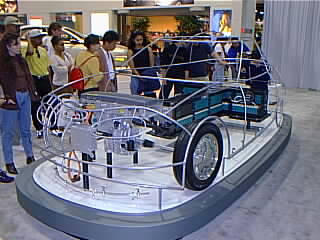
The slim gray box under the hood and just above the motor and transaxle is the most expensive part of the car, the power control module; the second-generation one in the 1999 models is half as thick as the first-generation one in the 1997 models, has one-third fewer parts, and costs half as much to make. So things are moving in the right direction! This model, by the way, was one of four models or working vehicles of different advanced-powertrain vehicles based on the EV1 that made their debut at last January's North American International Auto Show in Detroit, just after the Los Angeles Auto Show; since GM wanted to have the premiere in Detroit, they didn't show them in Los Angeles, and I had to read about them at the GM Ovonic website. I wish the folks who run the L.A. auto show would give up their first-of-the-year status so we wouldn't have to miss things like this that premiere in Detroit!
Speaking of cars that were in Detroit but not Los Angeles, Honda showed their "VV" two-seat hybrid-electric car up north the day after I went to the L.A. Auto Show. They also announced that it would be sold in the United States, Japan, and Europe as a 2000 model-year vehicle in late 1999; this beats the Toyota Prius four- (or five- ?) seat hybrid by a year. (One of the Toyota guys there told me that they were aiming to sell the Prius "in the Camry price range", by the way, so it will be comparable to the $16000 they're charging in Japan, where they've been for sale for about a year.) From the pictures I've seen, the "VV" prototype looks like it uses some of the same tricks as the EV1 to cut wind resistance: skirted rear wheels that are closer together than the front wheels, so that the car has more of a tapered, "teardrop" shape. I really wanted to see one "in the flesh", though! Oh, well, anyway, Honda brought their EV Plus, of course, and they had a CNG-powered Civic GX, which again was the first time I'd seen one unlocked at an auto show.
Well, I hope I have conveyed to you the impression I got, which was that a variety of alternative-fuel vehicles are available right now, and more are on the way in the next year or two! The automakers are making a serious effort to bring these advanced vehicles into the mainstream. In conclusion, speaking of the mainstream, I got a call yesterday from a gent on the east coast with Car and Driver magazine, the largest-circulation automotive magazine in the country if not the world; they are getting ready for a cross-country road-trip using CNG, and he wanted to discuss my experience with that. Now if getting alternative fuels into a Car and Driver road test isn't successful penetration of the mainstream, I don't know what is! [Note added 16 March 1999: As you can read in the April 1999 issue of the magazine, however, that trip didn't go well at all; I've posted a few comments about that.]
 Back
to AFV Events Page
Back
to AFV Events Page Back
to Fueling Station
Back
to Fueling Station Site
Map
Site
Map Contact
Me
Contact
Me All content copyright 1998-2024 by Mark Looper, except as noted. Reuse of my copyrighted material is authorized under Creative Commons Attribution 4.0 International license (CC BY 4.0).
![]()
![]()
new 5 January 1999, revised 16 March 1999